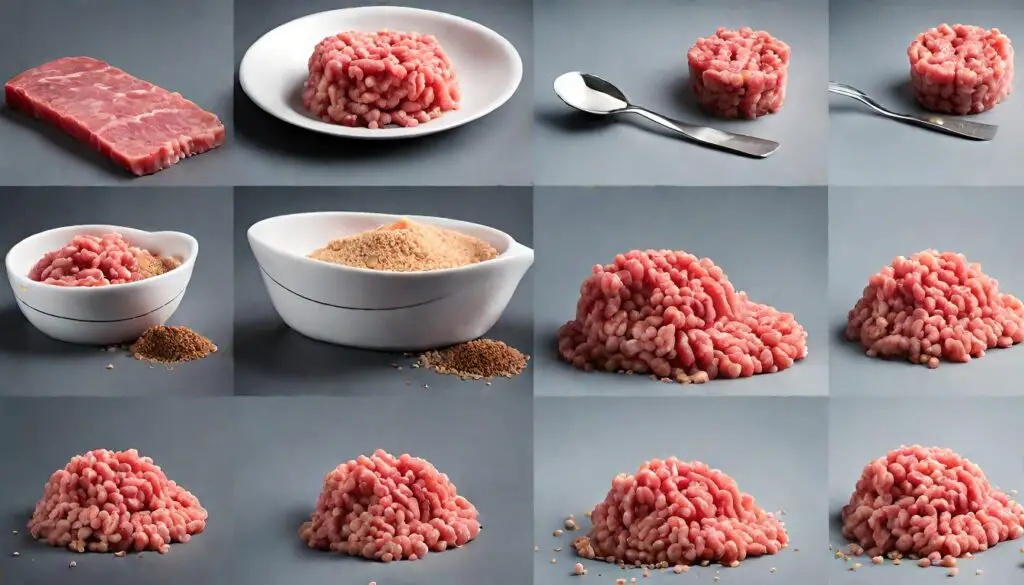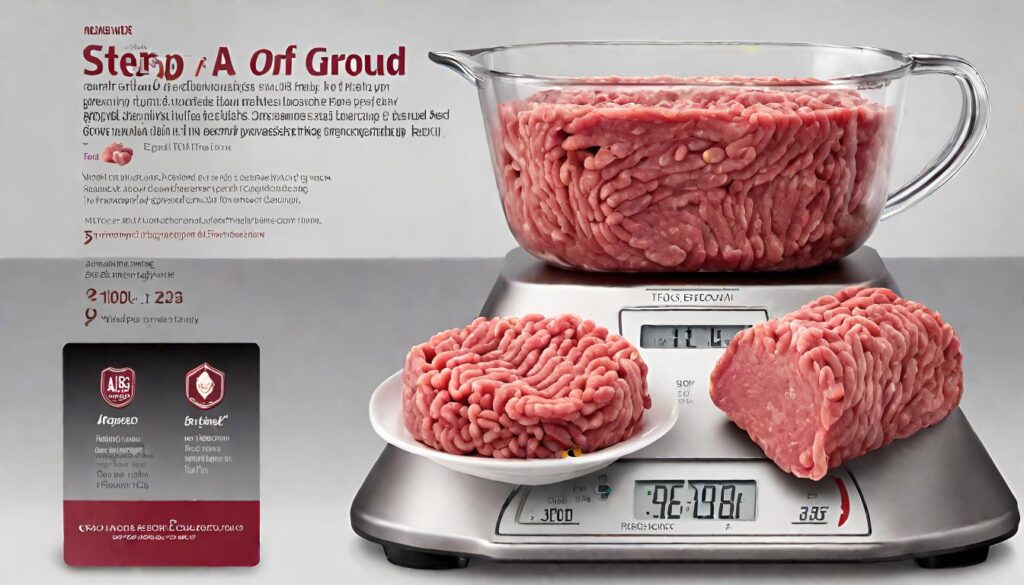In this comprehensive exploration, we delve into the world of ground beef calories, a staple in many diets renowned for its versatility and rich nutritional profile. From its calorie content to the myriad of health benefits and risks, we’ll cover every aspect you need to know. Whether you’re a fitness enthusiast, a health-conscious individual, or simply a lover of this protein-packed ingredient, this article promises to enlighten you about ground beef in ways you might not have considered before.
Part 1: Understanding Ground Beef and Its Nutritional Value
Ground beef, often a centerpiece in culinary delights from juicy hamburgers to hearty meatballs, is more than just a flavorful ingredient. It’s a nutritional powerhouse, packed with essential vitamins, minerals, and macronutrients. But what exactly makes ground beef such a significant part of our diet? Let’s break it down.
What is Ground Beef?
Ground beef, essentially, is beef that has been finely chopped or minced. It’s incredibly versatile, making it a go-to ingredient for countless recipes. But it’s not just about taste; ground beef is also a significant source of various nutrients essential for our body.
Nutritional Overview of Ground Beef
When we talk about the nutritional aspects of ground beef, it’s a tale of proteins, fats, and a host of micronutrients. A standard serving of ground beef packs a punch in terms of protein, making it an excellent choice for muscle building and repair. But that’s not all. Ground beef is also rich in essential nutrients like iron, which plays a crucial role in oxygen transport in the body, and B vitamins, vital for energy metabolism.
However, it’s not all rosy. Ground beef can be high in calories and saturated fats, which, when consumed in excess, can lead to health issues. This is where the type of ground beef you choose comes into play. Opting for leaner cuts can be a healthier choice, offering the same protein benefits with fewer calories and less fat.
In the next section, we’ll dive deeper into the caloric content and macronutrients present in ground beef, shedding light on how this everyday ingredient can fit into your diet in a balanced and healthy way.

Part 2: Caloric Content and Macronutrients in Ground Beef
Ground beef is often a staple in many diets, but understanding its caloric content and macronutrient breakdown is crucial for those mindful of their nutritional intake. Let’s delve into the details of what makes up this versatile meat.
Calories in Different Types of Ground Beef
The calorie content in ground beef can vary significantly based on its fat content. Typically, ground beef comes in various lean-to-fat ratios, such as 70/30, 80/20, and 90/10, with the numbers indicating the percentage of lean meat to fat. For instance, a 3-ounce serving of 85% lean ground beef contains about 218 calories. In contrast, the same amount of a leaner variant, say 95% lean, would have fewer calories. This variability underscores the importance of choosing the right type of ground beef based on your dietary goals.
Protein Content in Ground Beef
One of the standout features of ground beef is its high protein content. Protein is essential for muscle building, repair, and overall body function. In a 3-ounce serving of 85% lean ground beef, you can expect to find about 22 grams of protein. This makes ground beef an excellent choice for those looking to boost their protein intake, especially for athletes and bodybuilders.
Fat Composition in Ground Beef
The fat content in ground beef is a double-edged sword. While it contributes to the meat’s flavor and texture, it also adds to the calorie count and can impact heart health if consumed in excess. In the same 3-ounce serving of 85% lean ground beef, there are approximately 13 grams of fat, of which 5 grams are saturated fat. The American Heart Association recommends limiting saturated fat intake to reduce the risk of heart disease. Therefore, opting for leaner cuts of ground beef can be a healthier choice, providing the benefits of beef with less saturated fat.
In the next part of our series, we’ll explore the micronutrients present in ground beef, highlighting its role as a source of essential vitamins and minerals in our diet.

Part 3: Essential Vitamins and Minerals in Ground Beef
Ground beef isn’t just a source of macronutrients like protein and fat; it’s also rich in various micronutrients that play vital roles in our body. Understanding these can help us appreciate the nutritional value of ground beef beyond just its calorie count.
Iron and B Vitamins in Ground Beef
Iron is a standout mineral in ground beef, particularly important for its role in forming hemoglobin, which transports oxygen in the blood. The type of iron found in beef, known as heme iron, is more easily absorbed by the body compared to non-heme iron found in plant sources. This makes ground beef an excellent choice for preventing iron-deficiency anemia.
Ground beef is also a significant source of B vitamins, particularly B12, which is crucial for nerve function and the production of DNA and red blood cells. Other B vitamins present include niacin (B3), which aids in metabolism, and riboflavin (B2), important for skin health and energy production.
Zinc, Selenium, and Other Trace Elements
Zinc in ground beef contributes to immune function, wound healing, and DNA synthesis. It’s a mineral often found in ample amounts in meat and is essential for growth and development. Selenium, another trace mineral in ground beef, plays a role in thyroid hormone metabolism and reproduction. It also has antioxidant properties, helping to protect cells from damage.
These micronutrients underscore ground beef’s role in a balanced diet. While it’s important to manage portions and choose leaner cuts to control fat intake, ground beef can be part of a healthy diet, contributing essential nutrients often hard to obtain from other sources.
Part 4: Health Implications of Consuming Ground Beef
Ground beef, a popular protein source, has its share of health benefits and potential risks. It’s important to understand both sides to make informed dietary choices.
Benefits of Including Ground Beef in Your Diet
Ground beef is more than just a tasty addition to meals; it’s a nutritional powerhouse. Its high protein content is essential for muscle building and repair, making it a favorite among athletes and fitness enthusiasts. The presence of B vitamins, especially B12, supports neurological health and aids in red blood cell formation. Iron, another key nutrient in ground beef, is crucial for preventing anemia and improving energy levels.
Moreover, ground beef contains zinc and selenium, which are vital for immune function and overall health. These trace minerals play a role in everything from wound healing to antioxidant defense.
Potential Health Risks and Considerations
While ground beef has many benefits, it’s also important to consider its potential health risks. High consumption of red meat, particularly processed and high-fat cuts, has been linked to increased risks of heart disease, certain cancers, and other health issues. The saturated fat content in ground beef can contribute to higher cholesterol levels, which is a risk factor for heart disease.
To mitigate these risks, it’s advisable to choose leaner cuts of ground beef and moderate your intake, especially if you have existing health concerns or a family history of heart disease or cancer. Incorporating a variety of protein sources in your diet, including plant-based options, can also help balance your nutrient intake.
Explore our Chicken Tenderloin Recipes for more protein-rich meal ideas.
In the next part of our series, we’ll explore how ground beef can be incorporated into various diets, from low-carb to Mediterranean, ensuring a balanced and healthful approach to eating.
Part 5: Incorporating Ground Beef in Various Diets
Ground beef’s versatility makes it a fitting ingredient for various dietary approaches. Whether you’re following a specific diet for health reasons or personal preference, ground beef can be adapted to suit your nutritional needs.
Ground Beef in Low-Carb and Keto Diets
For those on low-carb or ketogenic diets, ground beef is a valuable food choice. Its high protein and fat content align well with the macronutrient requirements of these diets. In keto, for instance, where the focus is on high fat and moderate protein intake, choosing fattier cuts of ground beef can be beneficial. However, it’s important to balance this with heart-healthy fats and nutrient-dense, low-carb vegetables to ensure a well-rounded diet.
Ground Beef in Balanced and Mediterranean Diets
In balanced diets, including the Mediterranean diet, ground beef can be enjoyed in moderation. The Mediterranean diet, known for its heart-healthy approach, emphasizes plant-based foods, whole grains, and lean proteins. Here, ground beef should be lean and consumed less frequently, complemented with plenty of vegetables, fruits, and whole grains. This approach ensures you reap the benefits of ground beef while maintaining a diet rich in various nutrients and low in saturated fats.
Ground beef’s adaptability to different diets highlights its role as a versatile protein source. By choosing the right type of ground beef and balancing it with other food groups, it can fit into nearly any dietary pattern.
Looking for more hearty dishes? Check out our Delicious Gumbo Recipe for a taste of Southern comfort:
Delicious Gumbo Recipe: A Taste of Southern Comfort
Stay tuned for Part 6, where we’ll delve into the culinary world of ground beef, offering tips and ideas for preparing this versatile ingredient in a healthy, appetizing manner.
Part 6: Best Practices for Cooking Ground Beef
Cooking ground beef in a healthy and delicious way is both an art and a science. With the right techniques, you can maximize its nutritional value while enjoying a variety of tasty dishes.
Healthy Cooking Methods
The method of cooking ground beef can significantly impact its healthfulness. Opting for methods like grilling, broiling, or baking can reduce the fat content, as these methods allow fat to drip away from the meat. Stir-frying or sautéing in a small amount of healthy oil, like olive or canola oil, can also be a good choice. These methods not only preserve the flavor but also ensure you’re not adding unnecessary fats.
Creative Ground Beef Recipes
Ground beef is incredibly versatile, making it easy to incorporate into a range of recipes. For a healthier twist, try mixing ground beef with ground turkey for burgers – this reduces the overall fat content while maintaining flavor.
“For a sweet treat after your healthy meal, try our Small Batch Chocolate Chip Cookies.”
Small Batch Chocolate Chip Cookies
Adding beans and whole grains, like quinoa, to your beef chili can increase fiber and protein. Starting your meal with a salad topped with a small amount of cooked ground beef can also be a great way to enjoy this meat in moderation, ensuring you’re getting plenty of vegetables in your diet.
Remember, when cooking ground beef, it’s crucial to cook it thoroughly to an internal temperature of 160°F to ensure food safety. Also, be mindful of portion sizes – a healthy serving of ground beef is typically about 3 ounces, cooked.
Part 7: Frequently Asked Questions About Ground Beef Calories
In this final section, we address some of the most common questions surrounding ground beef and its caloric content, offering insights to help you make informed dietary decisions.
Common Queries and Expert Answers
Q: How many calories are in a serving of ground beef?
A: The calorie content in ground beef varies depending on the fat content. For example, a 3-ounce serving of 85% lean ground beef contains about 218 calories. Choosing leaner cuts like 95% lean ground beef will have fewer calories.
Q: Is ground beef good for weight loss?
A: Ground beef can be included in a weight loss diet if consumed in moderation and if leaner cuts are chosen. Its high protein content can be satiating, which helps in managing hunger.
Q: Can ground beef be part of a heart-healthy diet?
A: Yes, but it’s important to choose lean cuts and consume it in moderation. Pairing ground beef with heart-healthy foods like vegetables, whole grains, and healthy fats can also contribute to a balanced diet.
Q: How can I reduce the fat content when cooking ground beef?
A: Cooking methods like grilling, broiling, or baking allow excess fat to drip away from the meat. Also, draining the fat after cooking and rinsing cooked ground beef with hot water can reduce its fat content.
Q: Are there any risks associated with consuming ground beef?
A: Consuming high amounts of red meat, especially processed or high-fat cuts, has been linked to increased risks of heart disease and certain cancers. Moderation and choosing leaner cuts are key.
With these FAQs, we conclude our comprehensive guide on ground beef calories. Ground beef, with its rich nutritional profile, can be a valuable addition to your diet when consumed mindfully. By understanding its calorie content, health benefits, and potential risks, you can enjoy this versatile ingredient in a way that supports your overall health and well-being.








